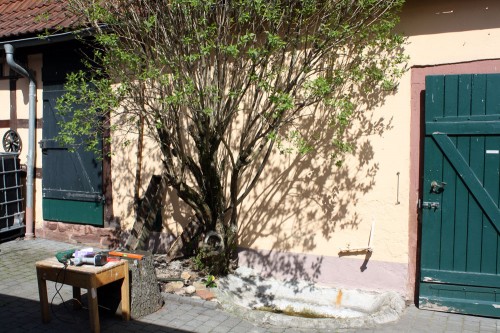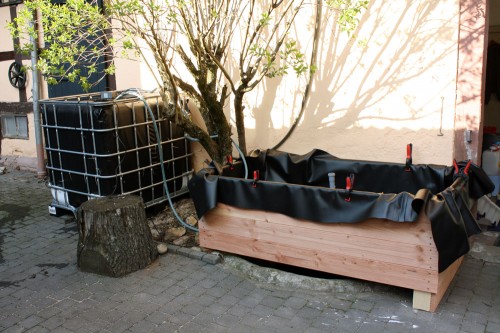Last weekend I had another one of those wild ideas that suddenly just manifests in your brain when you look at something. A little light goes off and you wonder why that thought never crossed your mind before. We get a lot of those around here. Pure moments of genius. Well, in our world anyway. And we always share them with one another in an almost apprehensive way; knowing what we’re about to say could sound totally insane when it’s out of our mouths. It’s always prefaced with one of us stating, “So I had this crazy idea…”
We’ve been thinking and talking about aquaponics systems for well over a year now. But we were always kinda scared to jump in because it all seems so complex. And when I say “we,” I completely mean “Stefan” here because things of this nature are really his territory. I am merely the assistant who does her best to make the process go smoothly (finding tools, parts, setting screws, finding screws, etc.)
If you’re reading this and wondering just what aquaponics even IS, it’s a fairly simple concept. Water from a fish tank feeds into a growing bed with aquaponics pebbles in which lettuce, tomatoes, herbs and just about any other sort of vegetable can be grown. The fish waste fertilizes the plants and you only have to feed the fish. You can grow worms or other plants just for the fish as well so everything is self-contained and self-sufficient.
The previous owner of our farm apparently used to have some free range ducks at one point…or at least that’s our guess about the mini-pond by our mudroom that once had a wooden ramp leading into it was in its hay day. It’s about 5 feet x 4 feet and a couple feet deep.
So I walked by this pond for the millionth time and I thought, “We should turn this into a food and fish growing paradise.” Then I turned to Stefan and asked, “Could we use the pond as a sump tank for an aquaponics setup?” Because I’d learned at least enough about aquaponics by then to know what would and wouldn’t work.
The gears in his head started turning and he quickly was obsessed with the idea. And so it began.
We decided to construct a platform directly over the pond which will be our primary grow bed. Finding a suitable plastic container to use for beds was useless so we decided to build the entire thing by 2″x2″ timbers and outdoor decking boards which we’ve used for other projects like our pump house and outdoor patio furniture.
We decided to use the IBC tank that we already had in the courtyard for rain water storage as our fish tank. That meant draining about 750 liters of water from it, most of which we were thankfully able to save for the sump tank and the refill of the fish tank.
Costs so far (in Euros)
| Pump | 44 |
| 2″x2″ Construction Beams | 44 |
| 120x180cm Plywood floor for grow bed | 15 |
| Pond foil 2m x 4m | 31 |
| Decking | 60 |
| Screws | 5 |
| Hoses & connectors | 15 |
| TOTAL | € 214 |
I’m going to go into a lot more detail about what we’ve done and built, which will hopefully be useful if you want to do something yourself. After 2 days of work (which included an excursion to the home improvement store for supplies), we’ve built the frame, floor and sides for the grow bed, put in the pond liner, built a drain, moved the IBC tank, hooked up the pump in the sump tank and set an overflow pipe from the fish tank to the grow bed.
We’ve still got to cut a larger hole in the top of the fish tank and will probably build a small grow bed to sit on top of it. This will cut off some of the light to the tank and also make it a little bit safer when little people learn to climb up the cage. Mackenzie was already trying that yesterday.
We also need a couple hundred liters of hydroponic pebbles, a frame to hold the pond liner in place and will eventually build some additional hanging wall channels with small pots of pebbles in them. We’re currently planning to grow cooking herbs, lettuce in the summer months when the salad table dries out too quickly, bell peppers and other goodies in the grow box. We’ll probably do strawberries on the wall.
We’re not sure what fish we’ll put in there yet. We’re considering tilapia or catfish…and may couple them with crawfish. But we also have to start thinking about a place for a breeding tank since it will get awfully pricey to keep buying fingerlings to eat…and with the right conditions these fish will breed like crazy.
If you’re thinking about starting an aquaponics setup, check out the first part of my aquaponics how to. Although it can be really difficult to find decent instructions about how to build your own aquaponics system, I hope we can shed some light on our process which may explain things. And since there’s bound to be problems at some point, you can learn from our mistakes too. 🙂





This is fascinating! I am interested to see how your set up works out.
I found your blog a few days ago (I think it was through a link from a UK blog) and I find it so interesting. My family and I are embarking on a self-sufficient live here in Canada–and it’s really fun to see how people can accomplish similar things in different countries, with different resources available to them.
We’re also very excited to see how it works out 😀 Since it’s right outside our kitchen and something we’ll see every day, we think it’s really going to do well. This is sort of a test for a bigger system that we want to eventually do in our garden behind our barn. Unfortunately that space is so far away from everything that it just gets neglected. One of the pitfalls of a very long, thin property…but better than no garden at all!
Finding materials like we’re used to in the US has been a real challenge for us. I mean they don’t even have typical small PVC pipes (1 inch size, etc)…everything is done with copper pipes. Instead we have to try electrical tubes that are similar to PVC…but there are no fittings for the ends. Insanity 🙂
Ive found some 1 inch PVC pipes. took a week but i have 2 fish tanks that are about 10ft by 25ft by 15ft custom made that hold about 35-40 fish each and we use one more as a breeding tank which is a good idea but if you have a long think property try digging a hole about 5ft down and have a tank that comes up another 5ft with a hold in the bottom that bings the water up via pump that can be powered by a home made wind turbin, not hard to make and thats what powers my system. but it comes throught the filter, the growing bed then through a tube that goes to the top of the tank at the other side so that it mixeds the water. i would provide a diagram and list of parts and a bill of materals but it would be long with my system and im sure not many would want to try and read it on a reply.
Lol i found this only because in my bio tech class we are making our own and so we have to do some research about the conditions and how its made. this has helped me out alot even though ive made some things at home that in short do alot of stuff like this but in a different way that stops it from bing borring. i have water go through a filter of rocks of all sorts then into a holing tanks that i have set up so that i can hit a button to oppen the gate and let it flow to the growing bed faster. this is where we have our fish feed, forget the name of the plant, but the gate is there so that when we need to we can send more water through as a flush once a week, get this it helps your plants grow a week faster and alot. im a man of science so i did my own tests 10 times with and without flushing the system once a week.
[email protected]
It’s great to see others working out the logistics and the excitement that comes with starting up your first aquaponics system! It can work amazingly, once it’s all set up correctly. I can attest that after a few years of growing this way, I still think it is the easiest method of gardening, and so much more water efficient :).
One thing I would suggest is that you move your growbed. You’ll need access to that sump some day, and having it buried and inaccessible seems like a good idea (especially around little people) until you have to work on the pump or something similar. Trust me, once you get all the grow media (clay pellets or rock or whatever you’re going to use) and then the water in that growbed, it will NOT be going anywhere without a whole lot of work. Been there, done that, lived to think it through for next time .
My husband and I actually teach aquaponics to newbies in Calgary, Alberta, Canada and it’s such a fun thing to show people how to do it, and how it can even be done in colder climates year round. We successfully grew all year last year right through the winter in a recycled portable garage frame sheathed in 7ml poly (clear house vapour barrier material) and one layer of bubble wrap. Our IBC fish-tanks are buried in the ground with insulation around them and a removable wood cover over the top, and with one 300 watt aquarium heater in the tank. We raise tilapia, which are a tropical fish and don’t do well in temperatures below about 17-18C, but they survived and thrived! We covered our grow beds with another layer of clear poly to trap the heat in as best as possible and grew bok choy and it did great. Next winter we’re going to do more cool-loving crops, like kale and spinach and broccoli and whatever else looks like a tasty thing to try, just to see what can survive our cold temperatures – last winter we had lots of days where outside temperature was in the -30C range.
I’m loving being able to pick fresh produce in my back yard, and teach others that it’s possible to do even in small spaces. I hope you enjoy the fruits of your labours every bit as much and have huge success in your aquaponics journey!
Donna Hayes
Alberta Aquaponics
Calgary, Alberta, Canada